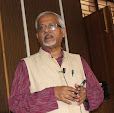
The palace of Akbar’s queen, Jodhabai, is an interesting structure inside Allahabad Fort. It cost Rs. 6.17 crore and was built in 45 years. History bears witness that Jodhabai was Akbar’s wife, irrespective of the controversy of Jodhaa-Akbar film.
CJ: Arindam Roy, 20 Feb 2008 Views: 4482 Comments: 1
EMPEROR AKBAR’S Fort in Allahabad, popularly known as Allahabad Fort, was a residential-cum-military fort. The plan of the fort took the form of a wedge (an irregular segment of a circle, with very wide dimension). It was 37 jarib (a 60 yards long chain) in length and 27 jarib in breadth, which is about 35.96 lakh square yards. Its cost at that time was Rs 6,17,20,214/- (Rupees six crore, seventeen lakh, twenty thousand, two hundred and fourteen only), according to Dr Prabakar Pandey, curatorial associate, Allahabad Museum.
Sriranjan Shukla, art historian and assistant keeper of Allahabad Museum, added that it took some 20 thousand men to construct the fort, in 45 years. It was planned out in four portions. In the first portion, buildings were constructed for private use, the second part of the building was meant for Begums (queens) and princes, the third portion was reserved for royal guests and the fourth portion was meant for soldiers and subjects.
Originally, it was an irregular triangle in outline, surrounded by lofty red sandstone wall. It had three magnificent gateways. One opened towards the Ganga, in the east, the second gate opened in the south, towards Yamuna, while the third gate opening on the landside was protected by a deep fosse and a low outer work, similar to that of the Agra fort. Years of degradation stole its grandeur. Otherwise, it could vie with the opulence of the forts at Agra and Delhi.
The British pruned down its towers and the high stone ramparts on the side were topped with turf parapets, obscured by a green sloping glacis. The south gate, opening towards Yamuna was closed and the upper storey of the main gateway was pulled down, leaving a bare concrete shell of the main dome, the interior of which still bears traces of its original beauty, in the shape of carved stone work and sadly worn out frescoes.
The celebrated Patalpuri temple and sacred Akshyavat stood at the site, prior to the Allahabad Fort. These religious spots are now inside the fort, at the outer courtyard, towards the Yamuna, in the south. Tradition says that devotees cast themselves from the Akshyavat, into the Yamuna, for Nirvana (salvation).
The palace of Akbar’s queen, Jodhabai, is also an interesting structure inside the fort, said Shukla.
He added that the Ashokan pillar, which was erected and set up at Kaushambi, was later removed and fixed at its present site by Emperor Jehangir. It contains six Ashokan inscriptions in Brahmi script, famous eulogy to King Samudragupta by his poet-minister Harisena, also in Brahmi script. Other than these, Persian inscriptions of Jehangir to commemorate his accession to the throne, two minor edicts and many later inscriptions are there on it.
(Link: http://www.merinews.com/catFull.jsp?articleID=130369












what are green sloping glacis?
ReplyDeleteSo he removed Ashokan pillars too? History has it own flavor, sometimes palatable sometimes tough to digest some facts.
It was a covered way of a fort, with an easy slope toward the field - typical fortification, now destroyed.
ReplyDeleteNo, not by Akbar but a later progeny, Emperor Jehangir (see last para of the story above)